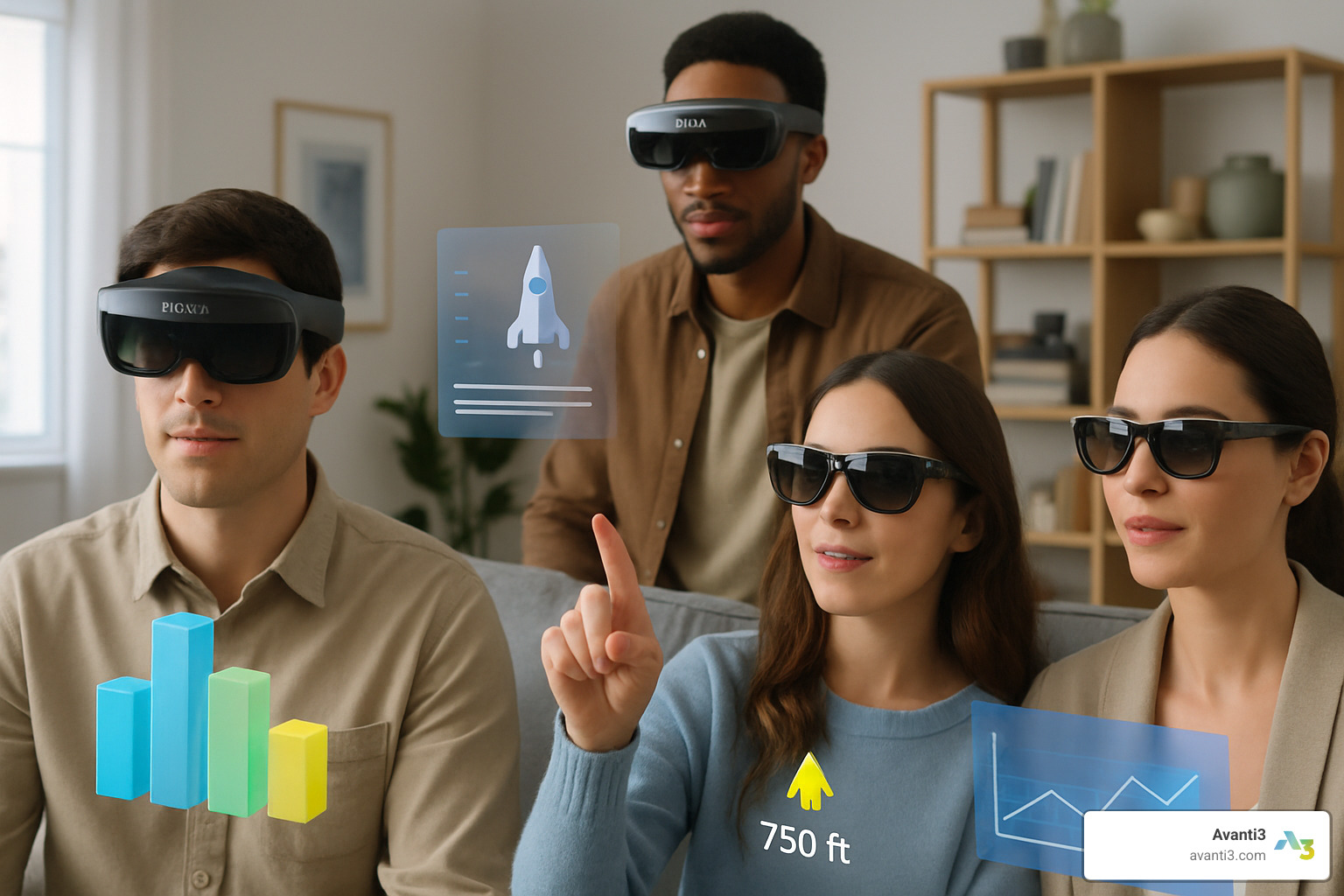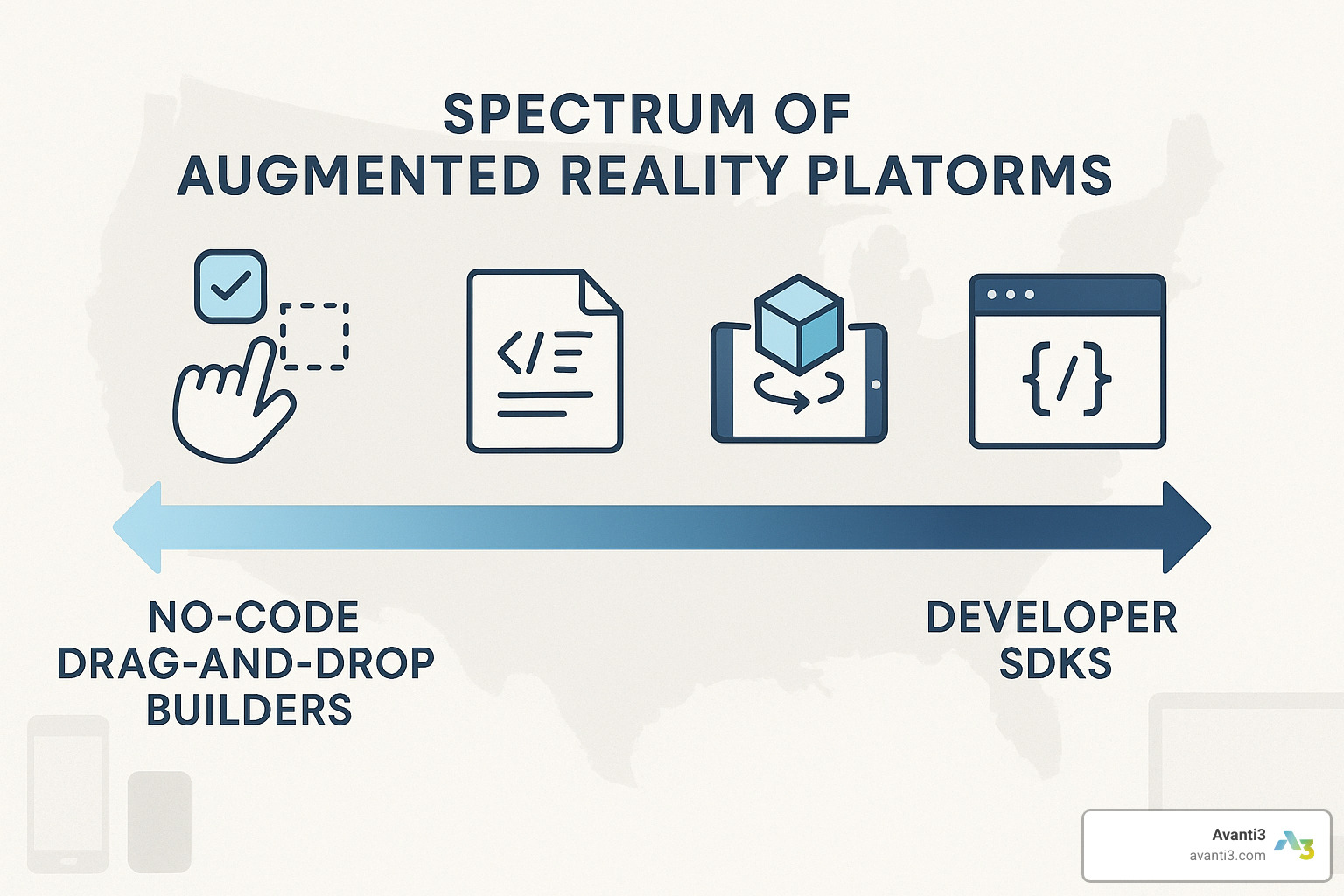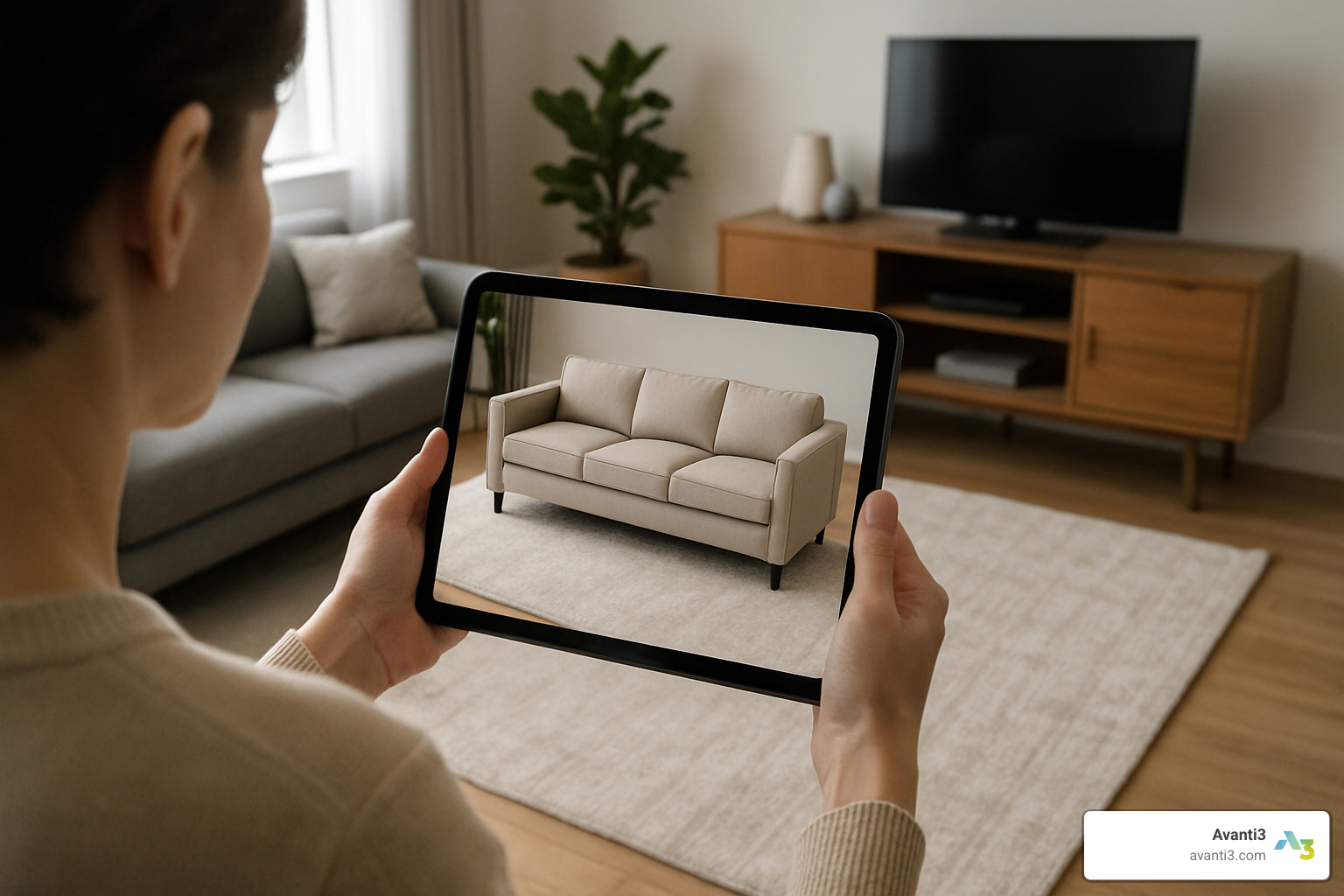Augmented Reality Platforms: 10 Powerful Best Picks 2025
The Rise of Augmented Reality Platforms in 2025
Augmented reality platforms are software frameworks that enable creators and businesses to develop experiences where digital content overlays the physical world. If you’re looking for the best categories of AR platforms to invest in for 2025, here’s a quick overview of the top contenders:
| Platform Category | Best For | Key Features | Typical Price Range |
|---|---|---|---|
| Cross-Platform Game Engine | Multi-device apps & games | Comprehensive SDK, 3D engine integration | $40/month+ |
| Mobile AR SDK | Android & iOS experiences | Geospatial APIs, depth sensing | Free to low cost |
| Device-Native Toolkit | Single-ecosystem focus | High-fidelity rendering, object capture | Free with dev account |
| Enterprise AR Suite | Industrial & field service | Advanced tracking, remote assistance | Custom pricing |
| No-Code Builder | Rapid marketing campaigns | Browser-based WebAR, intuitive interface | Free to $100+/month |
| WebAR Framework | App-less AR distribution | Visual Positioning, instant publishing | Free to custom pricing |
The market for augmented reality platforms has reached a pivotal moment in 2025. With over 150,000 registered AR developers creating more than 40,000 AR apps worldwide, businesses across industries are leveraging these technologies to transform how customers interact with their products and services.
According to recent data, AR experiences built with leading platforms can increase user engagement by up to 7 minutes per session – a significant boost compared to traditional digital media. This surge in interest isn’t surprising, as AR bridges the gap between digital and physical worlds in ways that were once confined to science fiction.
“It’s never been easier to bring your ideas to life in AR,” notes a leading developer portal, reflecting how these platforms have democratized access to technology that was once restricted to specialists with deep technical knowledge.
Today’s augmented reality platforms vary widely in their approach. Some prioritize ease of use with drag-and-drop interfaces that require zero coding knowledge, while others provide comprehensive development environments for creating sophisticated experiences with precise control. The best choice depends on your technical capabilities, budget, and specific use case.
I’m Samir ElKamouny AV, an entrepreneur and marketing expert who has helped countless businesses implement augmented reality platforms to drive engagement and sales. My experience with augmented reality platforms spans retail, education, and entertainment sectors, where I’ve witnessed how these technologies transform customer experiences and business outcomes.
Augmented reality platforms basics:
What is Augmented Reality & Why It Matters in 2025
At its core, augmented reality is a technology that overlays digital content onto the real world, creating an interactive experience where virtual elements coexist with physical ones. Unlike virtual reality, which creates a completely immersive digital environment, AR improves what we see, hear, and feel in our actual surroundings.
Modern augmented reality platforms rely on several key technologies:
- Computer Vision: Algorithms that help devices “see” and understand the physical world
- Spatial Computing: Technology that maps physical spaces and places digital objects within them
- Motion Tracking: Systems that follow device movement to maintain proper alignment of virtual objects
- Light Estimation: Features that analyze real-world lighting to render digital objects realistically
In 2025, AR matters more than ever because it’s become accessible enough for mainstream adoption while delivering genuine value across industries. From helping shoppers visualize furniture in their homes before purchasing to assisting technicians with complex repairs, AR bridges digital capabilities with real-world needs in ways that feel natural and intuitive.
2025 Market Snapshot: A Tipping Point for Augmented Reality Platforms
We’ve finally reached what industry insiders have been anticipating for years – the true “tipping point” for augmented reality platforms in 2025. It’s that magical moment where technology maturity, infrastructure, and user adoption have all converged to create something truly special.
What’s driving this extraordinary growth? It’s not just one thing, but rather a perfect storm of technological advancements coming together at just the right time.
The nationwide 5G rollout has been a game-changer for AR experiences. Remember when complex AR would stutter and lag? Those days are gone. With high-speed, low-latency networks now standard in most areas, cloud-streamed AR experiences run with a smoothness and fidelity that was unimaginable just a few years ago.
AI improvements have transformed what’s possible in augmented reality. Today’s machine-learning algorithms can recognize objects, understand complex scenes, and render digital elements in real-time with astonishing accuracy. This means AR experiences that truly feel integrated with your environment, not just awkwardly floating on top of it.

Cloud streaming capabilities have democratized access to sophisticated AR. Even if your smartphone isn’t the latest model, you can now access processing-intensive AR experiences that run on remote servers. This shift has opened up incredible possibilities for developers and dramatically expanded the potential audience.
The XR headset evolution has been remarkable too. Remember when smart glasses were bulky, expensive oddities? The latest generation is lighter, more stylish, and – crucially – more affordable. This has helped AR break free from the constraints of smartphones and become truly wearable technology.
Perhaps most exciting for developers is the standards convergence we’re seeing. Open, cross-platform specifications have simplified the development process across devices. This means creating once and deploying everywhere – a massive efficiency boost that’s accelerating innovation.
The numbers tell the story: projections show the global Web3 gaming market (which heavily leverages AR) approaching $29 billion by 2030, with an impressive 18.7% CAGR from 2023 to 2033.
The best part? We’re just getting started. As these technologies continue to mature and integrate, the possibilities for augmented reality platforms will only expand further.
Types of Augmented Reality Platforms
The AR platform landscape has evolved into a rich ecosystem catering to everyone from creative novices to seasoned developers. Whether you’re a marketer wanting to launch a quick campaign or an engineer building complex industrial solutions, there’s an augmented reality platform designed with your needs in mind.

No-Code Augmented Reality Platforms for Rapid Prototyping
Remember when creating AR required a computer science degree? Those days are gone! No-code platforms have thrown open the doors to AR creation, welcoming marketers, educators, and content creators into what was once an exclusive technical club.
These user-friendly platforms feature intuitive drag-and-drop interfaces that let you assemble AR scenes as easily as creating a PowerPoint presentation. With extensive template libraries, you can leverage pre-built interactions and effects rather than starting from scratch. The instant publishing capabilities mean you can test your creation immediately – no lengthy compile times or app-store approvals needed. Plus, most ensure cross-device compatibility with minimal fuss.
Many brands have successfully launched AR campaigns that activated hundreds of thousands of products and kept customers engaged for impressive average times of 7+ minutes – that’s gold in today’s attention economy!
Developer-Focused Augmented Reality Platforms
For teams who need to dive deeper into customization or optimize performance, developer-focused platforms provide the comprehensive tools to build truly unique experiences.
These platforms support programming in C#, C++, JavaScript and other languages, giving developers full creative control. They offer sophisticated SLAM APIs for precise environmental mapping, allowing virtual objects to interact convincingly with the real world. Built-in physics engines enable realistic interactions between digital and physical elements, while open-source components tap into community innovation. For professionals concerned about performance, these platforms offer extensive tuning capabilities to ensure smooth experiences even on less powerful devices.
Enterprise-Grade Augmented Reality Platforms for Industry 4.0
When it comes to industrial applications, healthcare solutions, or large-scale commercial deployments, enterprise platforms bring specialized capabilities to the table.
These robust solutions feature seamless IoT integration, connecting AR experiences to smart devices and sensors throughout manufacturing floors or hospital rooms. Their remote assistance tools enable expert collaboration across continents, while digital twin capabilities create virtual replicas of physical assets for training and maintenance. For regulated industries, built-in compliance features ensure adherence to strict standards, and comprehensive analytics dashboards help measure ROI and track usage patterns.
Cross-Platform Augmented Reality Frameworks for Mobile & Web
In our multi-device world, reaching users wherever they are has become crucial. Cross-platform frameworks make this possible with features designed for maximum accessibility.
These versatile tools provide iOS-Android parity so your AR experiences remain consistent regardless of device. Many support WebXR for browser-based AR that requires no app installation – removing a major friction point for casual users. Cloud anchors enable persistent multi-user experiences where digital content stays fixed in physical locations for multiple people to interact with. The device-agnostic design principles ensure your creation works well across phones, tablets, and emerging hardware.
| Capability | Mobile AR | WebAR |
|---|---|---|
| Installation | App download required | No download needed |
| Performance | Higher fidelity | Browser-limited |
| Distribution | App-store approval | Instant URL sharing |
| Updates | App updates needed | Real-time updates |
| Device Access | Full hardware access | Limited by browser |
| Monetization | In-app purchases | Web payment options |
The right augmented reality platform for your project depends on your technical resources, budget, timeline, and specific goals. Whether you’re creating a quick marketing campaign or building an enterprise-grade industrial solution, today’s diverse ecosystem has tools perfectly suited to bring your vision to life.
Feature Deep-Dive & Selection Criteria for Augmented Reality Platforms
Choosing the right augmented reality platform isn’t just about picking the shiniest new tech—it’s about finding the perfect match for your creative vision and technical needs. Let’s break down the key features that will make or break your AR project’s success:

Spatial Awareness & Environmental Understanding
The magic of AR happens when digital content truly feels part of your physical space. The best augmented reality platforms excel at understanding the world around you:
Plane detection is like giving your AR app a sense of where surfaces exist—that flat table where a virtual vase can sit or the wall where digital art belongs.
Depth APIs determine how realistically virtual objects interact with the real world. When that cute AR puppy runs behind your couch instead of through it, that’s depth understanding at work.
Semantic scene understanding takes things further by recognizing what objects actually are, allowing for more contextual interactions.
World-scale anchors let you pin AR content to specific geographic locations—perfect for city-wide scavenger hunts or location-based experiences that persist across users and time.
No-Code vs. Code: Advantages & Limitations
Think of this choice as similar to deciding between buying a ready-made cake or baking one from scratch. Both can be delicious, but they involve different skills and trade-offs.
No-code platforms offer wonderful accessibility—marketing teams can create AR campaigns without calling in developers, and ideas can go from concept to reality in hours instead of weeks. They’re perfect for quick prototyping and straightforward experiences. The trade-off? You’re limited to the features and templates the platform provides.
Code-based approaches give you the freedom to create nearly anything you can imagine. Want custom shaders that make your virtual water look exactly like your brand’s signature blue? Or complex interactions that respond to multiple gestures simultaneously? Coding makes this possible. The downside is the steeper learning curve and longer development timeline.
Many teams find success with a hybrid approach—prototyping quickly with no-code tools, then bringing in developers for custom refinements where needed.
Cross-Platform Reach & Future-Proofing
Today’s hot new phone is tomorrow’s obsolete tech, so thinking ahead matters. The best augmented reality platforms help you reach users wherever they are—now and in the future.
Smart-glasses readiness might seem premature to some, but the technology is advancing rapidly. Platforms that are preparing for this shift now will give you a competitive edge when consumer adoption increases.
Browser compatibility removes one of AR’s biggest friction points—the app download. With Web-based AR, users simply click a link and the experience begins. No app store, no waiting, no storage concerns.
Cloud rendering is the great equalizer, letting even modest devices run sophisticated AR by handling the heavy processing in the cloud. This approach helps future-proof your content against device fragmentation.
Pricing Models & Accessibility
Budget considerations are always part of the equation, and augmented reality platforms offer various approaches to pricing:
Freemium models let you dip your toes in without financial commitment, then scale up as your needs grow. They’re perfect for experimentation and learning.
Subscription plans provide predictable costs for ongoing projects, with tiered features based on your needs.
Enterprise licensing makes sense for large organizations deploying AR at scale and usually includes dedicated support and advanced features like remote assistance tools.
Usage-based pricing ties costs directly to actual engagement—you pay more when your AR experiences are successful and being used frequently, which can align nicely with business outcomes.
When budgeting, platform fees are just one piece of the puzzle. Consider the costs of 3D asset creation (which can range from $100 to several thousand per model depending on complexity), hosting charges, and ongoing updates to keep your experiences fresh and compatible with new devices.
Free starter options offer surprisingly robust capabilities for those just starting out, making AR more accessible than ever before. As your needs grow more sophisticated, comprehensive feature sets with scalable pricing are available.
Top Use-Cases & Success Stories Powered by Augmented Reality Platforms
The true value of augmented reality platforms becomes clear when examining real-world applications across industries. These success stories demonstrate how AR transforms user experiences and delivers measurable business outcomes.

Education & Training
Remember when learning about the human body meant flipping through flat textbook images? Those days are quickly fading as AR breathes life into education. Biology students now explore 3D cell models they can walk around and examine from every angle. Architecture students visualize building designs at actual scale right in their campus quad.
“I’ve seen students who normally sit in the back suddenly become the most engaged in class when we bring out the AR lessons,” shares one high-school science teacher who integrated interactive AR lessons into their curriculum. The platform makes learning “much more fun and alive” through captivating 3D content that students can interact with.
History classes are being transformed too, with students “visiting” ancient civilizations or witnessing historical events as if they were there. Technical training programs use AR to develop hands-on skills without the risk of expensive mistakes on actual equipment.
At Avanti3, we’ve witnessed how AR/VR immersive experiences boost retention rates. When students can physically interact with concepts, those ideas stick in a way that traditional methods simply can’t match.
Retail & E-Commerce
“Will this couch fit in my living room?” “How will this lipstick look with my skin tone?” These universal shopping questions are now being answered through AR before customers make a purchase.
Virtual try-on experiences have revolutionized online shopping for everything from eyeglasses to jewelry. Product visualization lets shoppers place that new refrigerator in their actual kitchen space, while 3D configurators allow them to customize products with different colors and materials in real-time. Even physical packaging has become an interactive experience, with AR-activated packaging bringing products to life.
The business impact is substantial. Retailers report conversion-rate lifts of up to 40% and as much as 30% fewer returns when customers use AR before purchasing. As one shopper put it, “I was hesitant to buy furniture online until I could see it in my actual space—now I won’t shop any other way.”
Avanti3’s Augmented Reality Marketing Solutions take this a step further by integrating Web3 technologies like NFTs, creating exclusive ownership opportunities alongside compelling visualization.
Field Service & Industrial Workflows
Imagine being a field technician facing a complex repair you’ve never encountered before. In the past, this might mean hours of delay while waiting for an expert to arrive. Today, augmented reality platforms are connecting workers with remote experts who can “see” through their eyes and guide them step by step.
“It’s like having our most experienced technician looking over my shoulder,” explains one field-service worker. Visual AR instructions overlay directly onto equipment, capturing expert knowledge and changing it into an easy-to-follow workflow.
Step-by-step guidance has reduced training time by up to 60% in some industrial settings, while quality inspection overlays highlight potential issues before they become costly problems. New technicians practice dangerous procedures through training simulations without any risk to equipment or personnel.
The result? Faster repairs, fewer errors, and significant cost savings across industrial operations.
Entertainment & Gaming
When location-based AR games sent millions of players hunting for virtual creatures around their neighborhoods, it showcased AR’s power to transform entertainment. But that was just the beginning.

Today’s location-based games create rich narratives tied to physical locations, while social filters have become a cultural phenomenon, with millions creating and sharing AR-improved content daily. The latest multi-player AR experiences allow friends to interact with the same virtual content simultaneously, whether they’re in the same room or across the world.
“My kids spent hours exploring our local park during an AR scavenger hunt,” shares one parent. “They were running, solving puzzles, and completely engaged—it was like watching the digital and physical worlds merge before my eyes.”
Sporting events and concerts now feature AR activations that improve the live experience. Imagine watching a baseball game where player stats appear as they step up to bat, or concert visuals that respond to the music and extend beyond the stage into the audience.
At Avanti3, we’re taking this further by connecting these AR moments with blockchain technology, creating digital collectibles that fans truly own. This combination of immersive experiences and genuine digital ownership is setting new standards for entertainment engagement.
Frequently Asked Questions about Augmented Reality Platforms
How do augmented reality platforms handle tracking and spatial mapping?
When people ask me how augmented reality platforms actually “see” the world around them, I like to explain it as giving your device a sense of spatial awareness – almost like teaching it to understand rooms and spaces the way we humans do.
Most modern augmented reality platforms rely on a clever combination of technologies working together. SLAM (Simultaneous Localization and Mapping) algorithms constantly build a digital map of your surroundings while tracking where your device is within that space. It’s pretty remarkable when you think about it – your phone is essentially creating an invisible 3D model of your living room in real-time!
Image-recognition capabilities let platforms identify specific objects or images that trigger AR content. Think of it as the system saying, “Aha! I recognize that logo on the cereal box – time to show the animation!”
Depth-sensing technology has made huge leaps forward recently. Whether using specialized LiDAR sensors on premium devices or clever computational algorithms on standard smartphones, these systems measure distances between objects with impressive accuracy. This is what allows virtual furniture to sit perfectly on your floor instead of floating awkwardly in space.
For location-based experiences, geospatial data comes into play, combining GPS coordinates, compass readings, and cloud-based information to place content at specific real-world locations.
Tracking quality varies significantly between different solutions. Native mobile SDKs provide robust environmental understanding on modern smartphones, while enterprise-grade options offer specialized tracking optimized for industrial applications. Web-based AR solutions typically have more limited tracking due to browser restrictions, though recent advances in browser-based SLAM technology are closing the gap.
What are the cost ranges for no-code versus developer AR solutions?
Let’s talk money – always an important consideration when choosing an augmented reality platform! The pricing landscape is diverse, with options for nearly every budget.
For no-code solutions that let you build without programming knowledge, you’ll typically find a tiered approach. Many platforms offer free starter tiers with basic features but limited publishing options. This is perfect for experimenting or creating simple personal projects.
When you’re ready to create commercial experiences, entry-level plans typically range from $19–$50 monthly, offering enough functionality for small teams and basic business use. As your needs grow, professional tiers ($100–$300/month) open up advanced features and higher usage limits.
For larger organizations with complex requirements, enterprise pricing is typically customized based on specific needs – just be prepared for a more substantial investment.
Developer-focused SDKs follow a similar pattern, though they’re often priced per developer. Free tiers usually include core functionality but may require attribution or include watermarks. Commercial licenses generally run $40–$100 monthly per developer, while enterprise licenses start around $500/month and include premium support plus advanced capabilities.
The platform subscription is rarely your only expense. You’ll likely need to budget for:
- Creating and optimizing 3D models (either in-house talent or outsourced)
- Cloud hosting for your content
- Analytics tools to measure performance
- Ongoing maintenance and updates
At Avanti3, we help clients steer these considerations to find the most cost-effective solution for their specific needs and budget constraints.
Can one project be deployed to mobile, web, and smart glasses simultaneously?
Yes, it’s absolutely possible to deploy AR experiences across multiple platforms – though it requires thoughtful planning and design. Think of it like creating a responsive website that works on phones, tablets, and desktops, but with additional dimensions of complexity.
Modern cross-platform frameworks have become incredibly powerful, allowing developers to build once and deploy to multiple environments. That said, you’ll still likely need some platform-specific code to take advantage of unique features on each device.
For maximum reach, Web-based AR is often the most accessible approach. Since it runs in browsers, it works across different devices without requiring app downloads. The trade-off is that browser-based AR typically offers fewer advanced features than native apps.
When designing cross-platform experiences, responsive design principles become crucial. Your AR content needs to adapt intelligently to different screen sizes, input methods (touch vs. controllers vs. gestures), and processing capabilities. A high-end AR headset can handle much more complex 3D models than an entry-level smartphone.
Asset optimization becomes particularly important in this context. Your 3D models and textures need different levels of detail for various devices – lightweight versions for mobile and web, with more detailed versions for powerful headsets.
In our experience at Avanti3, the most effective approach involves designing a core experience that works across platforms, then adding platform-specific optimizations that leverage the unique capabilities of each device. This approach maintains a consistent brand experience while ensuring optimal performance everywhere. Our community-building platforms take this cross-platform approach to create seamless experiences for users regardless of their device preferences.
Conclusion & Next Steps
As we’ve journeyed through the evolving landscape of augmented reality platforms, one thing becomes clear – AR is no longer a futuristic concept but a present-day reality changing how we interact with the world around us.
The AR revolution isn’t slowing down. In fact, we’re standing at the beginning of an innovation roadmap that will see these technologies become even more seamlessly integrated into our daily lives. The platforms we’ve explored are empowering creators, businesses, and developers to build experiences that once existed only in science fiction.
If you’re considering diving into AR in 2025, here’s some friendly advice from someone who’s been in the trenches:
Match your platform to your actual needs rather than being impressd by features you’ll never use. The most sophisticated developer SDK won’t help if your team lacks coding expertise, while a simple no-code builder might frustrate experienced developers who need deeper customization.
Always begin with crystal-clear objectives. I’ve seen too many AR projects fail because they started with the technology rather than the problem it needed to solve. Ask yourself: what does success look like for your specific use case?
The platform is just one piece of the puzzle. Consider your entire ecosystem – from content creation and 3D modeling to distribution channels and analytics. The most beautiful AR experience won’t matter if your audience can’t easily access it.
Augmented reality platforms are evolving rapidly, so choose solutions with room to grow. The platform that perfectly meets today’s needs might become limiting in six months as standards converge and new capabilities emerge.
Finally, accept the iterative process. Your first AR experience likely won’t be perfect, and that’s okay! Use analytics to understand how users interact with your creation and continuously refine based on real-world feedback.
As AR glasses become more mainstream and AI integration deepens, we’ll see experiences that are increasingly intelligent and contextually aware. The technical barriers will continue to fall, making creation accessible to more people with diverse backgrounds and perspectives.
At Avanti3, we’re passionate about combining these immersive technologies with Web3 innovations like NFTs and blockchain to create digital experiences that aren’t just engaging but also offer genuine value and ownership. Our approach to community-building platforms integrates these technologies to foster deeper connections between brands and their audiences.
Whether you’re an educator looking to transform how students learn, a retailer aiming to reduce return rates, or an entertainment brand seeking to create magical moments, today’s augmented reality platforms offer unprecedented tools to bring your vision to life.
The future belongs to those who accept these technologies thoughtfully and creatively. The question isn’t whether AR will transform your industry – it’s whether you’ll be leading that change or catching up to those who did.
Ready to explore how augmented reality can breathe new life into your business? Reach out to discuss how Avanti3’s blend of Web3, AR/VR, and AI solutions can help you build thriving digital communities that stand out in today’s crowded digital landscape. The future is augmented – and it’s already here.







